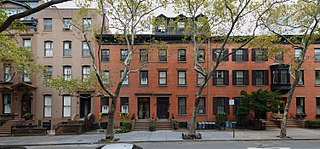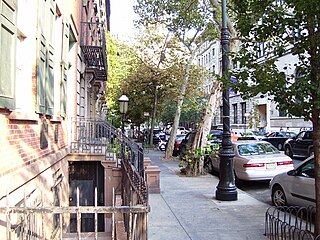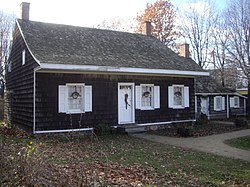
Flatlands is a neighborhood in the southeast part of the borough of Brooklyn in New York City. The current neighborhood borders are roughly defined by the Bay Ridge Branch to the north, Avenue U to the south, Ralph Avenue to the east, and Flatbush Avenue to the southwest.

Pearl Street is a street in the Financial District in Lower Manhattan, running northeast from Battery Park to the Brooklyn Bridge with an interruption at Fulton Street, where Pearl Street's alignment west of Fulton Street shifts one block south of its alignment east of Fulton Street, then turning west and terminating at Centre Street.

Ridgewood is a neighborhood in the New York City borough of Queens. It borders the Queens neighborhoods of Maspeth to the north, Middle Village to the east, and Glendale to the southeast, as well as the Brooklyn neighborhoods of Bushwick to the southwest and East Williamsburg to the west. Historically, the neighborhood straddled the Queens-Brooklyn boundary.

The following properties are listed on the National Register of Historic Places in Brooklyn.
Pieter Claesen Wyckoff was a prominent figure in Dutch and later English colonial Kings County, Long Island, New York. Most persons surnamed Wyckoff in North America, including many variations in spelling, can be traced to his family. After some time spent at Rensselaerwyck, near present-day Albany, New York, in 1655 Pieter moved his family into a rented house in New Amersfoort. Pieter Claesen prospered here, acquired land and became a local judge. He was influential in establishing the Flatlands Dutch Reformed Church at the juncture of Flatbush Avenue and Kings Highway in Brooklyn. The Wyckoffs are prominent members in Manalapan, New Jersey.

The Wyckoff-Garretson House is a historic house located at 215 South Middlebush Road, Somerset, New Jersey, which was built in 1730 by Cornelius Wyckoff. It is a contributing property of the Six Mile Run Historic District, added to the National Register of Historic Places on October 25, 1995.

The Center for Brooklyn History is a museum, library, and educational center founded in 1863 that preserves and encourages the study of Brooklyn's 400-year history. The center's Romanesque Revival building, located at Pierrepont and Clinton Streets in Brooklyn Heights, was designed by George B. Post and built in 1878–1881 by David H. King Jr., is a National Historic Landmark and part of New York City's Brooklyn Heights Historic District. The CBH houses materials relating to the history of Brooklyn and its people, and hosts exhibitions which draw over 9,000 members a year. In addition to general programming, the CBH serves over 70,000 public school students and teachers annually by providing exhibit tours, educational programs and curricula, and making its professional staff available for instruction and consultation.

The Dyckman House, now the Dyckman Farmhouse Museum, is the oldest remaining farmhouse on Manhattan island, a vestige of New York City's rural past. The Dutch Colonial-style farmhouse was built by William Dyckman, c.1785, and was originally part of over 250 acres (100 ha) of farmland owned by the family. It is now located in a small park at the corner of Broadway and 204th Street in Inwood, Manhattan.

The Alice Austen House, also known as Clear Comfort, is located at 2 Hylan Boulevard in the Rosebank section of Staten Island, New York City, New York. It was home of Alice Austen, a photographer, for most of her lifetime, and is now a museum and a member of the Historic House Trust. The house is administered by the "Friends of Alice Austen", a volunteer group.

The Bronck House, also known as the Pieter Bronck House, is a historic house museum west of Coxsackie in Greene County, New York. With a construction history dating to 1663, it is believed to be the oldest surviving building in Upstate New York, and is a well-preserved example of early Dutch and Swedish Colonial architecture. It was declared a National Historic Landmark in 1967. It is now a museum property managed by the county historical society.

The Wyckoff-Bennett Homestead in Flatlands, Brooklyn, New York City, is a National Historic Landmark. It is believed to have been built before 1766. During the American Revolution it housed Hessian soldiers, two of whom, Captain Toepfer of the Ditfourth regiment and Lieut. M. Bach of the Hessen-Hanau Artillerie, scratched their names and units into windowpanes. It was declared a National Historic Landmark in 1976. It is part of the New York State Revolutionary War Heritage Trail.

Priscilla is a classic oyster dredging sloop and museum ship at the Long Island Maritime Museum. Built in 1888, it is the oldest surviving boat from the Great South Bay oyster fleet, and was designated a National Historic Landmark in 2006. It is berthed near the Modesty, another National Historic Landmark sloop.

The Brooklyn Heights Historic District is a historic district that comprises much of the Brooklyn Heights neighborhood of Brooklyn, New York City. It was named a National Historic Landmark in January, 1965, designated a New York City Landmark in November, 1965, and added to the National Register of Historic Places in October, 1966.

The William Trent House is a historic building located at 15 Market Street in Trenton, Mercer County, New Jersey. It was built in 1719 for William Trent and is the oldest building in Trenton. He founded the eponymous town, which became the capital of New Jersey. It has served as the residence for three Governors. The house was added to the National Register of Historic Places and listed as a National Historic Landmark on April 15, 1970, for its significance as an example of Early Georgian Colonial architecture.

St. Mark's Historic District is a historic district located in the East Village neighborhood of Manhattan, New York City. The district was designated a city landmark by the New York City Landmarks Preservation Commission in 1969, and it was extended in 1984 to include two more buildings on East 10th Street. It was listed on the National Register of Historic Places in 1974 and was expanded in 1985. The boundaries of the NRHP district and its expansion are now coterminous with those of the LPC.

The Vander Ende–Onderdonk House, also known as the Van Nanda House, is a historic house at 1820 Flushing Avenue in Ridgewood, Queens, New York City. It is the oldest Dutch Colonial stone house in New York City.

The Cobble Hill Historic District is a municipal and national historic district located in the Cobble Hill neighborhood of Brooklyn, New York City. The national district consists of 796 contributing, largely residential buildings built between the 1830s and 1920s. It includes fine examples of Greek Revival, Italianate, and Queen Anne style row houses. Also in the district are a number of notable churches, including ones by Richard Upjohn and Minard Lafever, 1851–52). A number of early 20th century apartment buildings are part of the district as well.
This is a timeline and chronology of the history of Brooklyn, New York. Brooklyn is the most populous of New York City's boroughs, and was settled in 1646.
Dutch people have had a continuous presence in New York City for nearly 400 years, being the earliest European settlers. New York City traces its origins to a trading post founded on the southern tip of Manhattan Island by Dutch colonists in 1624. The settlement was named New Amsterdam in 1626 and was chartered as a city in 1653. Because of the history of Dutch colonization, Dutch culture, politics, law, architecture, and language played a formative role in shaping the culture of the city. The Dutch were the majority in New York City until the early 1700s and the Dutch language was commonly spoken until the mid to late-1700s.





















